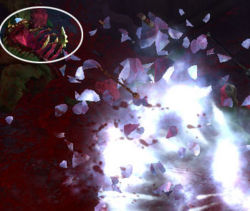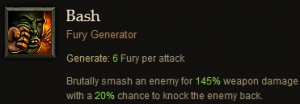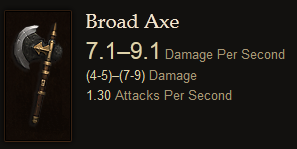Difference between revisions of "Combat"
(→% Weapon Damage on Skills) |
|||
| Line 125: | Line 125: | ||
==% Weapon Damage on Skills== | ==% Weapon Damage on Skills== | ||
| − | Nearly all skills in Diablo 3 are based on a weapon damage value. This measurement can be confusing because weapon damage can be misinterpreted to be the damage listed on your individual weapon tooltip itself, rather than your actual final damage after modifiers (such as +attack). | + | Nearly all skills in Diablo 3 are based on a weapon damage value. This measurement can be confusing because weapon damage can be misinterpreted to be the damage listed on your individual weapon tooltip itself, rather than your actual final "Character damage" after modifiers (such as +attack). |
[[Image:Bash.png|thumb|300px|Typical Skill using % Weapon Damage]] | [[Image:Bash.png|thumb|300px|Typical Skill using % Weapon Damage]] | ||
| − | When Skills refer | + | When Skills refer to doing "X% weapon damage", it is referring to your final adjusted "Character Damage" after passives and all stats/items, not the damage listed on the weapon itself. Character damage includes the total +Attack modifier (from the Attack Attribute) and any other item stats that affect your damage. It is simply your final damage as if you are attacking with a base attack. This does in fact mean that slower weapons will do more damage than faster weapons for that swing or cast, but it will take longer to perform the cast or swing. While this may appear to favor slow weapons, it is offset by both the ability to attack faster therefore more often, as well as faster resource generation via generator skills. Skills with cooldowns may favor slower weapons depending on your play-style, as you cannot perform that skill more than once, however the faster resource generation of faster weapons is used to offset this advantage by giving you extra resources hence doing more damage. |
| − | |||
==Dual wielding and Weapon Damage when using Skills== | ==Dual wielding and Weapon Damage when using Skills== | ||
Revision as of 07:55, 18 January 2012
Combat is the main activity engaged in while playing games in the Diablo series; they're not known as click-fests for nothing. Diablo isn't an RPG with a lot of social activities, or professions, or NPC dialogue. It's about killing vast hordes of evil monsters.
Every class in Diablo III is a DPS class; all are capable of prolifically slaying the enemies, whether by spells, skills, brute force, or a clever combination of all three.
Aspects of combat are addressed throughout this wiki. Weapons and skills are detailed, monsters are described, strategies are promoted, and more. This page covers the basics of combat, and how the game is designed to facilitate it, with numerous quotes from the D3 Team.
Contents
Damage Types
As in previous games in the series, there are numerous types of damage in Diablo III. Various spells, skills, skillrunes, and weapons channel their destructive might into one (or more) types of damage. Characters and monsters counter these attacks with equivalent types of resistance and immunities, and players must find the right balance of each if they wish to succeed in their battles.
Damage in Diablo III takes the following forms. Every form of damage can count for a critical hit (caused by various item or skill properties) and when a "crit" is landed, a bonus effect is added along with increased damage.
- Critical hit: Deals double damage.
Arcane Damage: Purple in coloration.
- Critical hit: Arcane crits "silence" targets. (Silenced targets can not cast some spells, such as a Skeletal Summoner or Goatman Shaman resurrecting fallen minions.)
Cold Damage: Blue in coloration.
- Critical hit: Cold crits freeze targets for 2 seconds.
Fire Damage: Red in coloration.
- Critical hit: Fire crits set targets ablaze, adding DoT to the initial fire damage.
Lightning Damage: White in coloration.
- Critical hit: Lightning crits stun targets for 2 seconds.
Disease Damage: Green in coloration. (Formerly known as "Toxic.")
- Critical hit: Disease crits deal an unknown bonus.
- Resisted by Poison resistance.
- Diseased units suffer a damage debuff; they take more damage and deal less.
Poison Damage: Green in coloration. (Also known as Acid.)
- Critical hit: Poison crits deal an unknown bonus.
- Resisted by Poison resistance.
- Poisoned units suffer a health debuff; their regeneration and healing is lessened or reversed.
Holy Damage: White in coloration. (Found mostly on Monk skills.) Extra damage to Undead?
- Critical hit: Unknown.
Spell Damage
The actual formula for spell damage is one of the biggest changes to combat in Diablo III. It's been changed to work much like physical damage does; spells now come with a fairly low base damage, much like weapons, and that value is acted upon by attributes, spells, traits, and equipment bonuses, all of which factor in to the final spell damage. Equipment with +%spell damage is quite common, and mage characters will want to collect as much equipment of that type as possible, in order to improve their killing power.
One of the biggest effects of this change is that spell casters will no longer be able to wearing all +magic find gear. A Wizard or Witch Doctor can wear that sort of gear if they want, but if they forgo +%spell damage equipment their killing power will be very poor; much like a physical damage character trying to play in Hell with a base damage weapon.
- See the Spell Damage article for full details.
Damage Types Update
Blizzard's @Diablo Twitter feed added some clarification about damage types in posts made in early December 2010.[1]
any change in the range of damage types to include holy, shadow, voodoo or anything else to match the classes? —Scyberdragon
Damage types will likely change some but are currently Physical, Fire, Lightning, Cold, Poison, Disease, Arcane, and Holy. —Diablo
Fairly significant in their difference, but both countered with a single resistance. Damage/resists aren’t design complete though.—Diablo
Whats the difference between poison and disease damage?—WickedBubba
Disease has a damage debuff (both intake and output), and poison has a health debuff (regen/heal). Subject to change of course.—Diablo
Is there much difference between poison and disease? They’re both internal maladies that hurt over a period of time.—Grug
Health Bar
In the Blizzcon 2008 build monsters' health bar were displayed in the centre of the screen above the opponent's head, but this has since been changed for various reason, not least it was distracting. The regular monsters' bar is now displayed at the bottom of the screen. The bar for uniques and bosses, (seen in the image on the left) was and remains in the top right of the screen.
Target Outline
One of the surprise controversies of Blizzcon 2009 was the red target outline. A new feature just added to the game was a glowing red outline around the monster being pointed at. This outline was meant to help players identify what they were pointing at on the frequently-crowded and chaotic battle screens of Diablo 3. Most players didn't mind or didn't even notice while playing at the show, but for some at Blizzcon, and for many others viewing screenshots and gameplay movies over the Internet, the red outline was bright and too obvious and distracting.
This became a minor issue of contention, but the D3 Team is very strongly behind the inclusion of the feature, as Jay Wilson made quite clear during an October, 2009 interview. [2]
- Jay Wilson: I consider it absolutely essential for target selection. We tried tons of other systems, and that’s the one that worked really well. The complaint we get is that it makes the monsters pop out from the world, and our response is that’s exactly what it’s supposed to do.
This feature remained controversial when it was seen in Blizzcon 2010 gameplay footage, though virtually no fans who have actually played the game have any complaints about it. It just stands out more noticeably in still images.
Information Through Graphics
The visuals tied to damage types are meant to add eye candy, but also to inform the player about events occurring on the screen. As Julian Love explained during BlizzCast #8, in March 2009. [3]
- Bashiok: A lot of the effects that you make factor in to the abilities that the characters are using, so fire and arcane and all that stuff, but in the world of Diablo it seems like there are very specific magic types that exist... it is actually a pretty broad spectrum, but is there any limitation there to what you can do with different damage types?
- Julian: Yeah in fact that’s a common input that I’ll receive is “Hey this guy’s a fiery this or whatever, but can we make that fire look green?” And that’s where the sort of designer in me has to kind of come out and say, wait a minute if we make fire green all of a sudden it’s a bit of a miscommunication in terms of the gameplay. And so there is a bit of constraint there that, at one point I’m trying to make things look as epic as they can, but at the same time they have to be really clear to the player so that they’re not confused that you know, green fire might mean poison. Then there’s the other part of it which is it’s really easy in my department to make a big mess. We can just clobber the screen with so many effects that you just can’t see the game anymore. So those are really the two constraints we really work with most.
Critical Hit Visuals
Critical hits inflict extra damage and/or bonus effects (detailed above). Various skills and items can improve the odds of a critical hit, as well as the damage it deals. Other skills or item effects trigger each time a critical hit is scored, creating an interesting and interconnected system of damage bonuses.
Critical hits existed in Diablo II, but they were indicated only by a small sparkle of white light. That concept has been vastly upgraded in Diablo III. Now, when a monster takes a "crit" there's a dramatic graphical effect, especially if the death is due to crits. Monsters so slain literally explode, shattering into gory chunks that fly across the screen and litter the ground. These animations are customized for whatever type of damage killed them; flames will be seen on the hunks of meat if the critical was fire-based, sparks rise from lightning, etc. Physical damage crits leave huge slicks of blood and give a battlefield a lovely post-massacre patina.
- See the critical hits page for much more detail.
In Depth Combat
One criticism of earlier games in the series is that they are fairly one-dimensional, in terms of combat. One or two skills can be used over and over again, in almost every situation, and there's little thought required. This was especially the case in Diablo II, where players were nearly god-like in their powers and could easily escape almost any dangerous situation by running or teleporting away. The D3 Team wants to make combat much more tactical in D3; it will still be a fast-paced, click-intensive Action RPG, but there should be a bit more strategy required than "click 'til dead."
Jay Wilson talked about the shallowness of combat in D2, and his plans to deepen it in D3 with 1up.com in December 2008.
- The combat model doesn't have a lot of depth in the previous games. It was very much a "one-skill spam" kind of game, which I think works great for the Normal [difficulty] playthrough. I think most of the audience is just fine with that, and through most of the Normal difficulty, it's going to be like that. But as you go into Nightmare and Hell difficulties, I think that the more serious player will appreciate a game that's a little deeper on the combat-mechanic side.
- 1up.com: What makes Diablo 3's combat deeper than its predecessors?
- Jay Wilson: Combat is as deep as the options the designers give themselves. Whenever you add a new capability to a monster -- potentially something that feels unbeatable -- it's more of an opportunity to expand the depth of your characters so they can respond to those threats. A good example would be if you look at Diablo 2: There were a couple of problems with just the power of the characters and the way they were made powerful. A player could run faster than any monster, so you could escape just about any threat. You had endless health and resource -- by resource, I mean mana -- because of potions. And you had the Town Portal, which could instantly get you out of any problem. Those were incredibly powerful mechanics to escape danger and were not class-specific. So every kind of class really had no need for anything like an escape skill or reactionary ability. They simply needed to attack, and if they ever got in over their heads, they simply ran away or drank potions. And it's the same response across the board.
- So one of the things we focused on is that response -- 1) setting up scenarios where the players can't easily get out of danger without the use of class-specific skills, and 2) giving them really simple controls to use a broader range of skills without making the game that much more complex to play. I really distinguish the difference between complexity and depth; to me, complexity is adding more buttons, while depth is making a single button more powerful and versatile. So that's always been our goal -- reducing the amount of controls while making each button mean more. So that's one of the reasons we added the Hotbar; it's one of the reasons why we avoided the potion-health system. And when people play the game, they may not notice this next point that much, but we leveled out the movement speed somewhat so that the player moves at a more reasonable rate compared to the monsters.
More Immersive/Difficult Combat
Diablo III does not include Town Portals, life leech is very rare, and Healing Potions carry a substantial cool down after each use. These changes (amongst others) were made to improve the combat and immersive feeling of the game. The developers felt that potions, life leech, and town portals were exploited in Diablo II, and were a chief reason for the game being very easy 99.9% of the time, and unfairly hard (due to one-hit kills) the other .1%.
The design goal of Diablo III is to make combat more immersive and challenging. Characters cannot heal so easily and cannot flee combat at any time (via town portals), thus the monsters are more difficult and dangerous, even without the potential for cheesy/buggy one-hit kills. The developers hope this will create a more tense, exciting atmosphere and make combat feel more real and intense.
% Weapon Damage on Skills
Nearly all skills in Diablo 3 are based on a weapon damage value. This measurement can be confusing because weapon damage can be misinterpreted to be the damage listed on your individual weapon tooltip itself, rather than your actual final "Character damage" after modifiers (such as +attack).
When Skills refer to doing "X% weapon damage", it is referring to your final adjusted "Character Damage" after passives and all stats/items, not the damage listed on the weapon itself. Character damage includes the total +Attack modifier (from the Attack Attribute) and any other item stats that affect your damage. It is simply your final damage as if you are attacking with a base attack. This does in fact mean that slower weapons will do more damage than faster weapons for that swing or cast, but it will take longer to perform the cast or swing. While this may appear to favor slow weapons, it is offset by both the ability to attack faster therefore more often, as well as faster resource generation via generator skills. Skills with cooldowns may favor slower weapons depending on your play-style, as you cannot perform that skill more than once, however the faster resource generation of faster weapons is used to offset this advantage by giving you extra resources hence doing more damage.
Dual wielding and Weapon Damage when using Skills
When performing a skill that is based on % weapon damage and you are dual wielding, your character will alternate between both weapons that are equipped. For example, if you swing with your right hand weapon, than the next attack you perform will be with your Left-hand weapon, and that will be used in the %weapon damage calculation. This may give the illusion that dual-wielding is inferior to 2-handed weapons because you are in essence using a 1-hand weapon to perform the skill (which has lower damage than a 2 hand weapon), however dual-wielding offers a passive 15% attack speed bonus which increases your resource generation as you are attacking more often, as well as the added stats granted by equipping a second weapon.
| Items of Diablo III [e] Item Basics Normal Items Crafting Legendary Armor I Legendary Armor II Legendary Weapons 1h Legendary Weapons 2h Item Sets |
|---|






